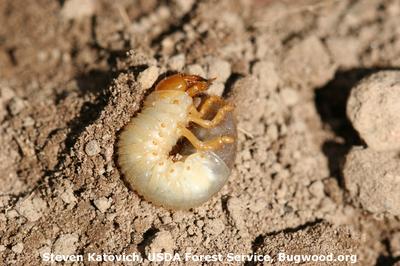May Beetles
Phyllophaga spp.
Insect
In a Nutshell
- Wilted and discolored plants.
- Purple stem.
- Stunted growth.
- Beetles are 12 to 25 mm long, yellow to reddish-brown or black, robust with an oblong shape.
Can also be found in
Symptoms
May beetles cut main roots or chew off fine root of mature plants. This hinders the uptake of water and nutrients, which usually results in stunted, wilted, and discolored canopy. Emerging seedlings can also be attacked, resulting in patches of wilted growth in the field or simply gaps in the rows. Typically, the stem of the injured plants turns purple, indicating phosphorus deficiency. Cool, wet soils will exacerbate the situation because the growth of corn seedlings will be slowed and remain susceptible for a longer time.
Recommendations

Organic Control
Natural enemies that control white grubs include parasitic wasps in the genera Tiphia and Myzinum, and the species Pelecinus polyturator. Parasitic flies include the species Pyrgota undata. The fungi in the genus Cordyceps also infect the larvae and can be used in solutions to control their populations. Inoculating the soil with bacterial spores of Bacillus popilliae and Bacillus lentimorbus can also help to reduce populations. All of these products are available commercially.

Chemical Control
Always include an integrated approach with both preventive measures together with biological treatments if available. Management of white grubs requires a thorough monitoring of the fields before planting to detect their presence. Fumigation with soil insecticides can be used to reduce populations to an acceptable level. Seeds treatment also helps to reduce the impact of white grubs in some cases but usually no chemical treatment is recommended.
What caused it?
The damage is caused by the larvae of several beetles belonging to the genus Phyllophaga (over 100 different species). Other types of beetles may be involved and therefore, it is important to learn how to recognize them. The beetles are about 12 to 25 mm long, yellow to reddish-brown or black, robust, and with an oblong shape. Larvae are whitish with a brown head and C-shaped, 20 to 45 mm in length and with three pairs of legs. The hind portion of the abdomen is dark and slightly enlarged because of the soil particles showing through the body wall. The life cycle of these insect can vary widely and this makes preventive control measures essential to keep populations in check.
Preventive Measures
- Grow more tolerant varieties if available.
- Change planned planting date to avoid peak populations of beetles.
- Monitor field by digging up some plants in the affected area and looking for white grubs in the root zone.
- Rotate with non-host crops such as deep-rooted legumes (alfalfa or clovers).
- Keep the field free of grass and weed growth to reduce the number of eggs laid.
- Avoid to sow corn in fields previously used for soybean or potato.
- Expose the insects to predators with a mid-season plowing.
- Deep plow, remove and burn harvest residues and stubbles after harvest.
- Alternatively, use pasturing hogs to unearth and eat grubs.
- Avoid overuse of insecticides as these will also affect natural predators of white grubs.



